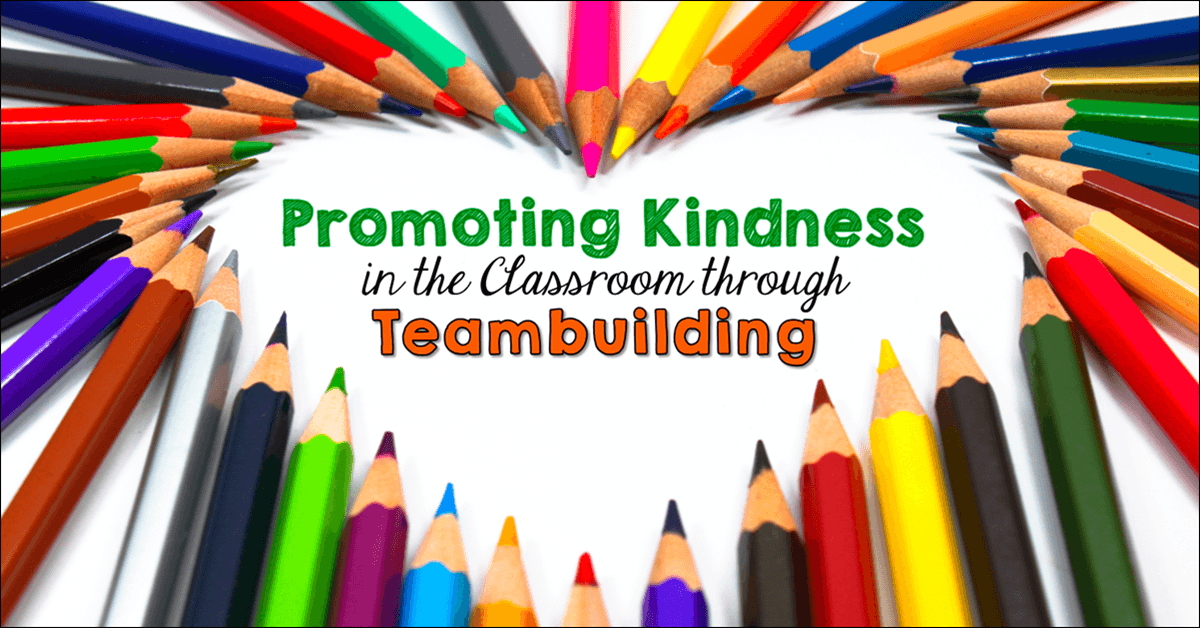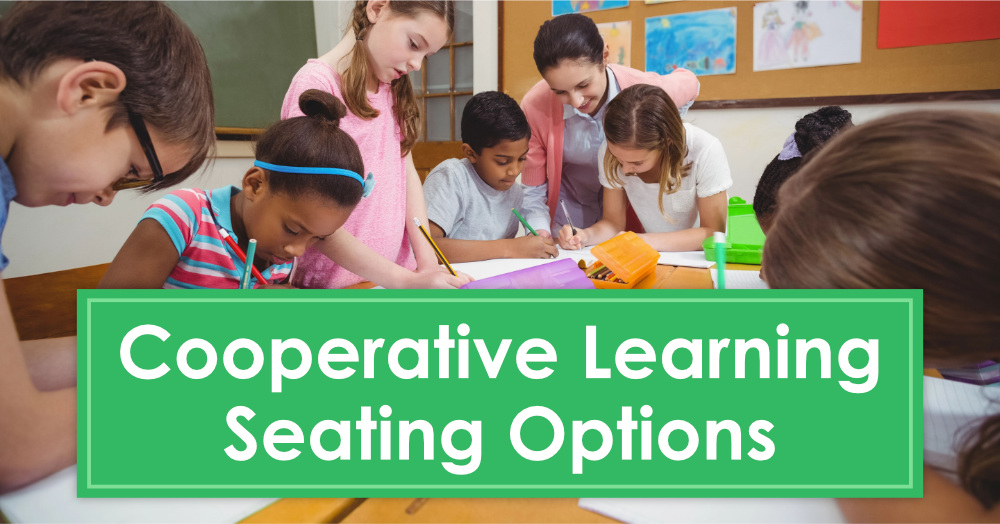With the attention given to the Common Core Informational Text and Literacy Standards, it’s easy to overlook the other ELA standards, especially the Speaking and Listening Standard. But even though this is not a tested area, speaking and listening skills are extremely important. Knowing how to participate actively in a discussion involves the highest level of communication; both speaking and listening skills are required to be effective. Often it’s through talking over ideas with others that we are able to dig deeply into core concepts and understand them fully.
Teaching Kids How to Have Effective Group Discussions
Unfortunately, oral communication skills don’t come naturally to students. We have to teach those skills explicitly and provide opportunities to practice them. Perhaps that’s why the very first speaking and listening anchor standard is, “Prepare for and participate effectively in a range of conversations and collaborations with diverse partners, building on others’ ideas and expressing their own clearly and persuasively.”
Effective discussions are the foundation for all collaborative work, and there are two strategies I use regularly to promote these skills:
- Think-Pair-Share for whole group discussions
- Talking Sticks for small group discussions
Before I share HOW to use these strategies, let’s take a look at WHAT your students might be discussing when they practice collaborative discussions. Fortunately, the Informational Text and Literacy Standards give us the perfect opportunity to engage our students in effective discussions and teach them how to communicate clearly. These standards are rigorous, and in order to fully explore the concepts outlined in the standards, students must discuss them in both a whole group setting and in small cooperative learning groups or guided reading groups. The standards require far more than finding fact and opinion, making predictions, making connections, and many of the skills we have taught previously.
Creating Standards-Based Reading Questions
After examining the K-5 reading standards in detail, it occurred to me that an easy way to meet many of them would be to involve students in standards-based literary discussions. Simply take each standard, convert it into a series of related questions, and then apply those questions to a read-aloud or other shared text.
For example, Standard RI.3.2 is, “Determine the main idea of a text; recount the key details and explain how they support the main idea.” After you convert that standard into a few related questions, it reads, “What is the main idea presented in this text? How is the main idea supported by specific details?”
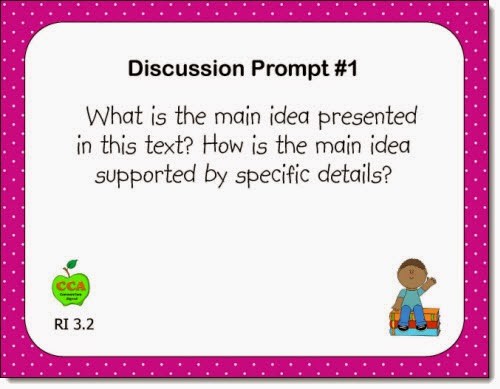
You can create these questions yourself, but I’ve done the work for you by creating sets of Common Core Discussion Prompts for each grade level, K-5. Each grade level includes three sets of prompts: Personal Response, Informational Text, and Literature. The prompts are available in both a full sized PowerPoint format to display for the class and a smaller task card format to use in small groups. The questions to display for the class include the specific standard numbers right on each slide. You can purchase these items from my TeachersPayTeachers store.
Using Think-Pair-Share to Foster Effective Group Discussions

After creating a set of standards-based questions, the next step is to present them to your class in conjunction with a relevant text. For the question above, you’ll need a short informational text selection that can be read aloud to your students or that they can read in a basal text. If you are using an entire book, limit your read aloud session to just a few pages that have one clear main idea. For example, Nature’s Green Umbrella has several pages that describe the rain forest, several pages about why rain forests are endangered, a few pages about rain forest solutions, and so on. After students read the text or listen to you read it, use the Think-Pair-Share strategy to discuss the question as a class. Follow these steps:
- Think and Write – Present the standards-based questions for discussion, “What is the main idea of the text? What are the key details? How do those details support the main idea?” Give students a few minutes of individual think time to jot down the main idea and at least 2 key details.
- Pair and Discuss – Pair students with a partner and ask them to compare their ideas about the main idea and key details. Ask them to discuss how those details support the main idea.
- Share with the Class – Call on individual students to share what they discussed with their partner as the main idea and supporting details. Before you confirm any responses as being correct, call on at least 3 or 4 students to share their thoughts. Ask if anyone disagrees, and teach them how to disagree politely and support their idea with details.
Using Talking Sticks to Foster Small Group Discussions
After you introduce each standards-based question in a whole group setting, it’s time to introduce them in small groups. You can do this in small guided reading groups using the Talking Sticks strategy I described in an earlier blog post.
Each team is given a cup with “talking sticks,” or craft sticks, and teach team member is given 2 or 3 sticks. Throughout the discussion, students use the craft sticks to signal that they have something to contribute to the discussion. They give up a stick when they are called upon to speak, and when they run out of sticks they may not speak again until everyone else is out of sticks. This strategy is great for equalizing participation and keeping individual students from dominating the discussion.
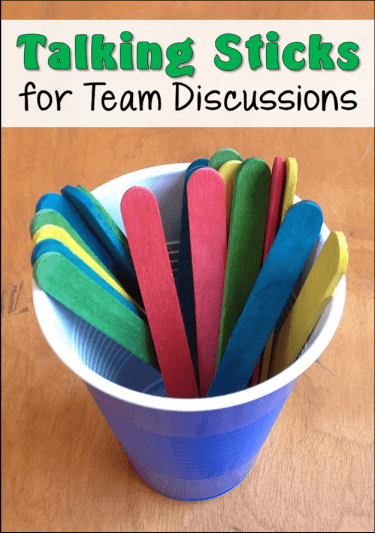
I created sets of CCSS Aligned Talking Sticks task cards for grades K – 5 that have the exact same questions as the full-sized discussion prompts. The nice thing about these cards is that they are the perfect size for small groups. You’ll find complete directions for using the strategy in each Talking Sticks Mini Pack. You can also purchase the full-sized discussion prompts and the Talking Sticks task cards as a CCSS Aligned Reading Discussion Combo.
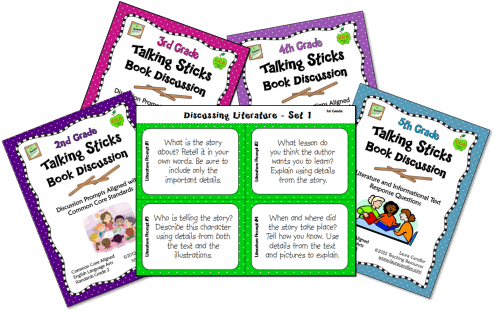
If state-testing is looming in the near future for your students, standards-based discussions are a terrific way to prepare them for the rigors of those tests. But even if testing is over, or you don’t teach in a school system that has adopted the Common Core, it’s important to teach students how to engage in effective discussions. Both Think-Pair-Share and Talking Sticks are excellent strategies to boost oral communication skills, and they’ll take your students to the core of effective discussion.



